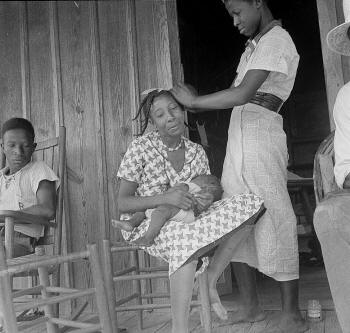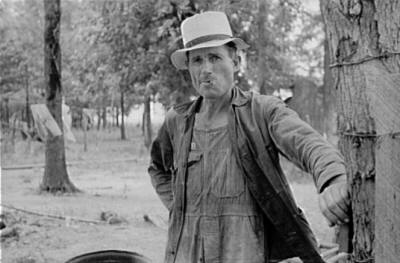University
Communications
Office
Arkansas State University
Jonesboro,
Arkansas
Staff
Markham Howe
Sara McNeil
Gina Bowman
(870) 972-3056
fax (870) 972-3693
More information:
NewsPage
Links to News Releases
& Announcements
Campus Calendar
Public activities at ASU
About
ASU
Overview, history
and more |
Southern Tenant Farmers Museum offers
photographic exhibit, special presentation, May 21
May 7, 2009 --
The
Southern Tenant
Farmers Museum, 117 Main Street, Tyronza, is currentl y hosting Marjorie
J. Hunter’s exhibit “Hope and Despair: FSA
Photography in Arkansas during the Great Depression,” beginning Tuesday,
May 5 and running through June 30. Due to the
immense popularity of this exhibit, its run has been extended through
Wednesday, July 22. On Thursday, May 21, at 7 p.m., the
museum will present a special presentation by Marjorie J. Hunter, a
history teacher at West Memphis High School and a student in the
Heritage Studies PhD program at Arkansas State University-Jonesboro.
Admission is free, the public is welcome, and refreshments will be
provided. y hosting Marjorie
J. Hunter’s exhibit “Hope and Despair: FSA
Photography in Arkansas during the Great Depression,” beginning Tuesday,
May 5 and running through June 30. Due to the
immense popularity of this exhibit, its run has been extended through
Wednesday, July 22. On Thursday, May 21, at 7 p.m., the
museum will present a special presentation by Marjorie J. Hunter, a
history teacher at West Memphis High School and a student in the
Heritage Studies PhD program at Arkansas State University-Jonesboro.
Admission is free, the public is welcome, and refreshments will be
provided.
“Hope and Despair” is a collection of more than 30 rarely
viewed Farm
Service Administration photographs taken in Arkansas by such noted
photographers as Walker Evans, Dorothea Lange, Russell Lee, Edwin Locke,
Carl Mydans, Arthur Rothstein, Ben Shahn, and Marion Post Wolcott. The
photos illustrate more than the poverty and desperation of the Great
Depression; they also illustrate the indomitable endurance of
individuals in eastern Arkansas. Hunter developed the project under the
direction of Dr. Clyde Milner II, Heritage Studies program director, and
she selected and compiled the photographs from the Library of Congress
archives.
The exhibition’s images include sharecroppers near Blytheville, children
chopping cotton in Marked Tree, and people in the Forrest C ity
refugee camp. The pictures have the original captions describing the
activity, place, or date the photograph was made. The starkness of the
photographs and the lack of specific details encourage viewers to
formulate their own interpretations of these historic works. ity
refugee camp. The pictures have the original captions describing the
activity, place, or date the photograph was made. The starkness of the
photographs and the lack of specific details encourage viewers to
formulate their own interpretations of these historic works.
“One reason I chose this group of photographs was to examine how these
families developed a sense of reliance on the community during hard
times,” Hunter explained. “My PhD dissertation in Heritage Studies
focuses specifically on the women’s networks that provided shared
information and emotional support to survive the Depression. These
public-domain photographs allow us a glimpse into these forgotten
lives.”
The Farm Security Administration (FSA) was initially created as the
Resettlement Administration (RA) in 1935 as part of President
Franklin Delano Roosevelt’s New Deal projects. The FSA attempted to
combat rural poverty in America. The photography project initially
documented the RA’s cash loans to individual farmers and the agency’s
construction of planned suburban communities. The second stage of
the project focused on the lives of sharecroppers in the
South and of migr atory
agricultural workers in the Midwest and the West.
As the scope of the project expanded, the photographers turned to
recording rural and urban conditions throughout the United States. atory
agricultural workers in the Midwest and the West.
As the scope of the project expanded, the photographers turned to
recording rural and urban conditions throughout the United States.
To convince the general public of the need for the agency’s mission,
Roosevelt appointee and head of the FSA, Rexford Tugwell appointed Roy
Stryker as “Chief of the Historical Section,” with the assignment of
photographing the devastated land and people that were the agency’s task
to rescue. Under Stryker’s direction, the Information Division adopted a
goal of “introducing America to Americans.” His camera crew took
thousands of pictures, and members of the team, such as Lange, Evans,
Rothstein, and Shahn, gained reputations as leading creators of
documentary photography.
“The photographs depict a wide range of emotion from hopefulness in the
eyes of a child to despair carved in the faces of the adults,” Hunter
said. “All of them show abject poverty and the desperation found in
being a sharecropper during the Great Depression.”
The Southern Tenant Farmers Museum, one of ASU-Jonesboro’s Heritage
SITES (System Initiatives for Technical and Educational Support), is
located in the historic Mitchell-East Building at 117 Main Street,
Tyronza. The museum’s mission is to enhance knowledge and understanding
of tenant farming and agricultural labor movements in the Mississippi
River Delta. The museum seeks to preserve the history and promote the
legacy of sharecropping, tenant farming, and the farm labor movement.
Museum hours are 9 a.m.-4:30 p.m., Monday-Friday, and 12 noon-3 p.m. on
Saturday. Admission to the museum is free.
For more information about the “Hope and Despair” exhibition, or other
special events at the Southern Tenant Farmers Museum, contact
Linda Hinton, assistant
director, at (870) 487-2909, or e-mail
stfm@ritternet.com.
###
Photographs, from top:
Marjorie Hunter, creator of "Hope and Despair: FSA Photography in
Arkansas during the Great Depression."
Dorothea Lange's "Negro Women," Earle, Arkansas, is one of the images
featured in "Hope and Despair."
Arthur Rothstein's "Sharecropper," Wilson Plantation, Wilson, Arkansas,
is another of the FSA images on display at the Southern Tenant Farmers
Museum through June 30.
|
